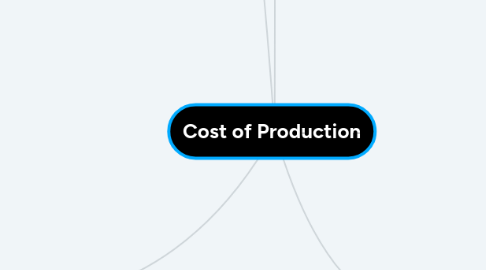
1. Short Run
1.1. Definition
1.1.1. A period of time in which at least one FOP is fixed in qty
1.1.2. Output increased only through more variable factors
1.2. Costs
1.2.1. Fixed Costs
1.2.1.1. Definition : do not vary with amt of output produced, e.g. rent for restaurants, costs of machines
1.2.1.2. cost remain even if output=0
1.2.2. Variable Costs
1.2.2.1. Definition: vary directly with amt of output produced, e.g. payment for ingredients, salaries
1.2.2.2. Doesn't increase @ constant rate
1.2.2.2.1. 1) increases at decreasing rate initially
1.2.2.2.2. 2) increases at increasing rate
1.2.3. Total Costs= TFC +TVC
1.2.4. Average Costs
1.2.4.1. AFC
1.2.4.1.1. Fixed Costs per unit of output produced.
1.2.4.1.2. AFC =TFC/Q
1.2.4.2. AVC
1.2.4.2.1. Variable Costs per unit of output
1.2.4.2.2. AVC = TVC/Q
1.2.4.3. ATC
1.2.4.3.1. AC= AFC + AVC
1.2.4.3.2. AC = TC/Q
1.2.5. Marginal Costs
1.2.5.1. Definition: increase in TC that arise from production of an additional unit of output
1.2.5.2. MC = ΔTC / ΔQ
1.2.5.3. MC = = ΔTVC / ΔQ (in short run, constant TFC)
1.2.6. Cost Curves
2. Long Run
2.1. Definition
2.1.1. A period of time in which all factor of production can be varied in quantity
2.2. Costs
2.2.1. Long Run Costs
2.2.1.1. LRAC: shows lowest unit of cost firm can attain at every given output lvl
2.2.1.2. Profit=max firm will use least costly combi of factors to produce any given output = productively efficient at that output.
2.2.1.3. For the firm, any pt. on LRAC is productively efficient.
3. Cost
3.1. Definition
3.1.1. Economists'
3.1.1.1. Implicit + Explicit costs= Total opp costs
3.1.1.2. Economic Profit+ Total opp costs = TR
3.1.2. Accountants'
3.1.2.1. Explicit Costs = TC
3.1.2.2. Accounting Profit + TC = TR
3.1.3. Implicit Costs: Opp. Costs
3.1.3.1. opp costs from factor inputs
3.1.3.2. opp costs from FOP
3.1.4. Explicit Costs: Tangible, incurred when firm makes actual monetary payment
4. Economies of Scale
4.1. Internal EOS
4.1.1. Firm's cost per unit of output decreases as firm expands scale of production
4.1.2. Types of Internal EOS
4.1.2.1. Technical EOS
4.1.2.1.1. Specialisation and division of labour
4.1.2.1.2. Indivisibilities
4.1.2.1.3. Greater efficiency of large numbers
4.1.2.2. Financial EOS
4.1.2.3. Managerial EOS
4.1.2.4. Commercial/Marketing EOS
4.1.2.5. Risk-bearing EOS
4.2. Internal DOS
4.2.1. Increasing scale of production leads to higher cost per unit of output.
4.2.2. Factors
4.2.2.1. 1. High cost of monitoring and management
4.2.2.2. 2. X-inefficiency
4.2.2.3. 3. Low morale of manangement
4.3. External EOS
4.3.1. A firm's costs per unit of output decreases as whole industry expands
4.3.2. Factors
4.3.2.1. Avail. of shared resources
4.3.2.2. Infrastructure
4.3.2.3. Industry-specific skilled labour
4.4. External DOS
4.4.1. Increase in firm's long-run AC due to expansion of industry
4.4.2. Factors
4.4.2.1. Strain on physical infrastructure
4.4.2.2. Shortage of industry-specific infrastructure

